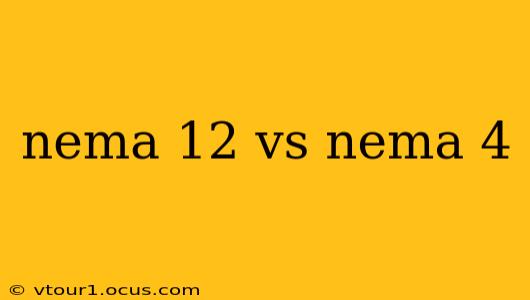Choosing the right electrical enclosure is crucial for protecting sensitive equipment from environmental hazards and ensuring safety. Two common ratings, NEMA 12 and NEMA 4, are often compared, but understanding their differences is vital for making informed decisions. This comprehensive guide will delve into the specifics of NEMA 12 and NEMA 4 enclosures, highlighting their strengths and weaknesses to help you select the best fit for your application.
What is a NEMA Rating?
Before comparing NEMA 12 and NEMA 4, let's briefly define what a NEMA rating represents. NEMA (National Electrical Manufacturers Association) ratings classify the degree of protection provided by an enclosure against various environmental factors. These ratings are essential for ensuring the safety and longevity of electrical equipment in diverse operating conditions. The number designates the level of protection offered; a higher number generally indicates greater protection.
NEMA 12 Enclosures: Indoor Protection
NEMA 12 enclosures provide protection against dust, falling dirt, and dripping non-corrosive liquids. They are suitable for indoor environments where the risk of severe environmental exposure is minimal. Key characteristics include:
- Protection: Offers protection against dust, falling dirt, and dripping non-corrosive liquids. It doesn't provide protection against water jets or immersion.
- Applications: Ideal for indoor environments with minimal exposure to moisture or extreme temperatures, such as industrial control panels, electrical equipment in offices or cleanrooms, and HVAC systems in controlled settings.
- Material: Typically constructed from sheet metal or plastic.
- Cost: Generally more affordable than NEMA 4 enclosures due to their simpler design and construction.
NEMA 4 Enclosures: Watertight and Dust-Tight Protection
NEMA 4 enclosures offer significantly more robust protection compared to NEMA 12. They are designed to withstand water splashes, hose-directed water, and dust ingress. This makes them suitable for more challenging environments.
- Protection: Provides protection against splashing water, hose-directed water, and dust. Offers a higher level of protection against water ingress compared to NEMA 12.
- Applications: Commonly used in outdoor applications, wet environments, and areas exposed to washdowns, such as food processing plants, chemical facilities, and marine applications.
- Material: Often constructed from heavier-gauge steel or corrosion-resistant materials like stainless steel. Gaskets are crucial for maintaining the watertight seal.
- Cost: Typically more expensive than NEMA 12 due to the enhanced construction and materials required to meet the higher protection standards.
NEMA 4X Enclosures: Enhanced Water Protection
It's important to note that a closely related rating, NEMA 4X, offers even greater protection than NEMA 4. NEMA 4X enclosures provide the same protection as NEMA 4 against dust, water, and corrosion but are specifically designed to withstand more frequent and intense washdowns, using high-pressure water jets. This is a crucial distinction for applications demanding rigorous cleaning.
Choosing Between NEMA 12 and NEMA 4: Which One is Right for You?
The choice between NEMA 12 and NEMA 4 depends entirely on the specific environmental conditions and the level of protection required for your equipment.
- Choose NEMA 12 if: You need basic protection against dust and dripping liquids in a clean, dry indoor environment. Cost is a primary concern, and the risk of significant water exposure is minimal.
- Choose NEMA 4 if: Your equipment needs protection from splashing water, hose-directed water, and dust ingress. The environment is potentially wet or exposed to frequent cleaning. Durability and long-term protection are crucial.
What are the differences between NEMA 12 and NEMA 4X?
NEMA 4X enclosures offer similar protection to NEMA 4 against dust and water but provide superior resistance to corrosion and are designed for frequent and intensive washdowns with high-pressure water jets. The extra "X" designates the superior corrosion resistance.
What are the common applications for NEMA 12 enclosures?
NEMA 12 enclosures are commonly used in indoor applications where dust and dripping liquids are the main concerns, such as industrial control panels in cleanrooms or offices.
What are the common materials used for NEMA 4 enclosures?
NEMA 4 enclosures are typically made from heavier-gauge steel or corrosion-resistant materials like stainless steel to withstand harsh conditions.
Are NEMA 4 enclosures suitable for outdoor use?
Yes, NEMA 4 enclosures are often used in outdoor settings due to their superior protection against water and dust. However, additional considerations, like UV resistance, may be necessary depending on the specific environment.
By understanding the key differences between NEMA 12 and NEMA 4 enclosures, you can select the appropriate level of protection for your equipment, ensuring its safety, longevity, and optimal performance. Remember to always consult the specific product specifications to verify the exact level of protection offered by a particular enclosure.
